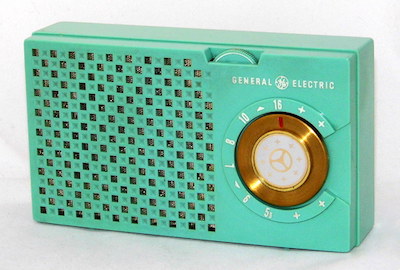Both you faithful readers know that I’ve always been fascinated by technology and have often times come into possession of some of the first ones of the “technologically advanced” devices produced. (One of the very first H-P Scientific Calculators, one of the early TRS-80 computers, subscribed to AOL before it was AOL, etc.) I’ve mentioned several times that my dad had a Motorola television set a number of years before any commercial radio stations west of the Mississippi started broadcasting.
The transistor was invented in the late 1940s, but until 1954 transistors were only used in military or industrial applications. Colleges didn’t even really teach courses on transistors when I went to school in the late 50s and early 60s. I had one course on transistors when I was in school, and that wasn’t even a course on transistors — it was more of a physics course on “holes and electrons.”
But anyhow, I’ve wandered a little bit off course…. The first commercially manufactured pocket transistor radio was the Regency TR-1. It was a novelty due to its small size, but it really didn’t work very well — most people described its performance as mediocre. But nonetheless, about 150,000 TR-1s were sold. I never owned a TR-1, but I did own the 2nd all-transistor pocket radio — made by General Electric. [Just to clarify, Raytheon produced the 2nd all-transistor radio, the 8TP, at the beginning of 1955, but it was a “large” portable radio – not pocket size.] GE’s all-transistor pocket radio measured 5 5/8 inches long, 3 3/16 inches high and 1 1/2 inches deep. It weighed 15 ounces. The retail price was $49.95 — a lot of money in 1955.
In 1956, GE added two more models, 677 and 678, to it’s lineup. I graduated from high school in 1956 and received a shiny model 678 as graduation present — a VERY nice gift! I suppose I fell into the “curious” category growing up, so I immediately took my new radio apart — the insides were like nothing I had ever seen. I’d taken a lot of old radios apart, but this looked nothing like a radio — it was almost all one solid piece, but it did have discrete components, like resistors, capacitors, and a mechanical tuning mechanism.
For any “geeks,” the radio contained five General Electric germanium transistors. And for older “true geeks,” four of the transistors were PNP — one ( the AF detector) was NPN. All the components, including the transistors, were soldered to one side of a printed circuit board.
The battery used to power the radio was an Eveready #239. Batteries have always been a problem for electronic equipment and became more so as the size of the equipment became smaller and smaller. The #239 battery that powered my radio had 3 female pin holes at the top, labeled (-), (9v), and (13.5v). Naturally, I took the battery apart too, and found that it was made up of 9 individual 1.5 volt batteries that were all stacked in series. The battery also had voltage taps at 4.5 volts and 9 volts, and of course all the cells together produced 13.5 volts. The batteries weren’t that easy to find and fairly expensive. If you couldn’t find an Eveready #239, a Rayovac 1900, Burgess XX9 or RCA VS304 would all work.
The radio in the picture was my graduation present — I had the radio for years and it never stopped working, but eventually it became almost impossible to find a battery. As you probably know, most earlier transistor radios migrated to a single 9-volt battery that is still popular today in all sorts of devices, including smoke detectors. As technology advanced, a lot of devices were designed to operate using AA or AAA batteries.
I should note that the radio was AM only — had a tuning range of 540 kHz – 1620 kHz. No one much listens to AM anymore… of course no one much listens to a radio anymore… sigh….
— 30 —

